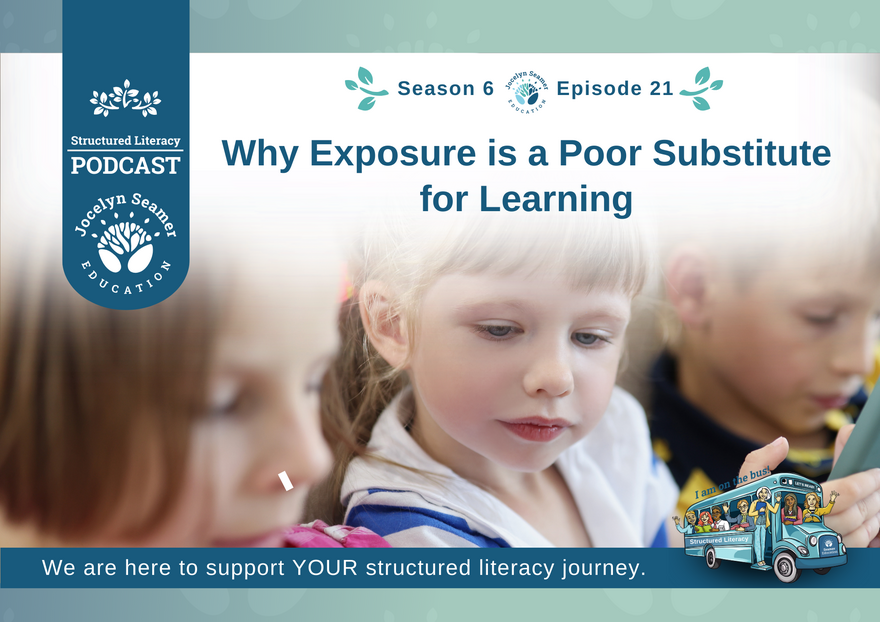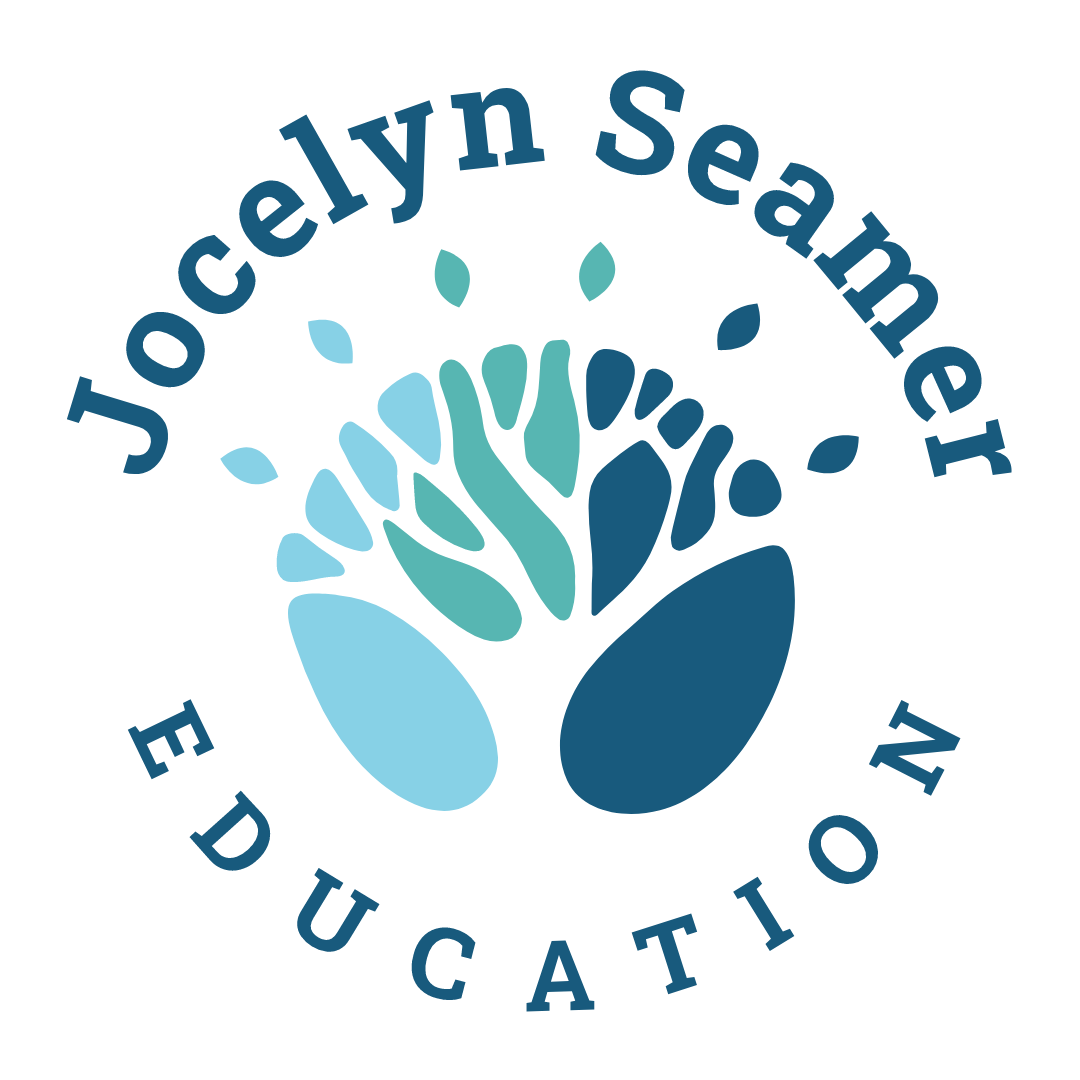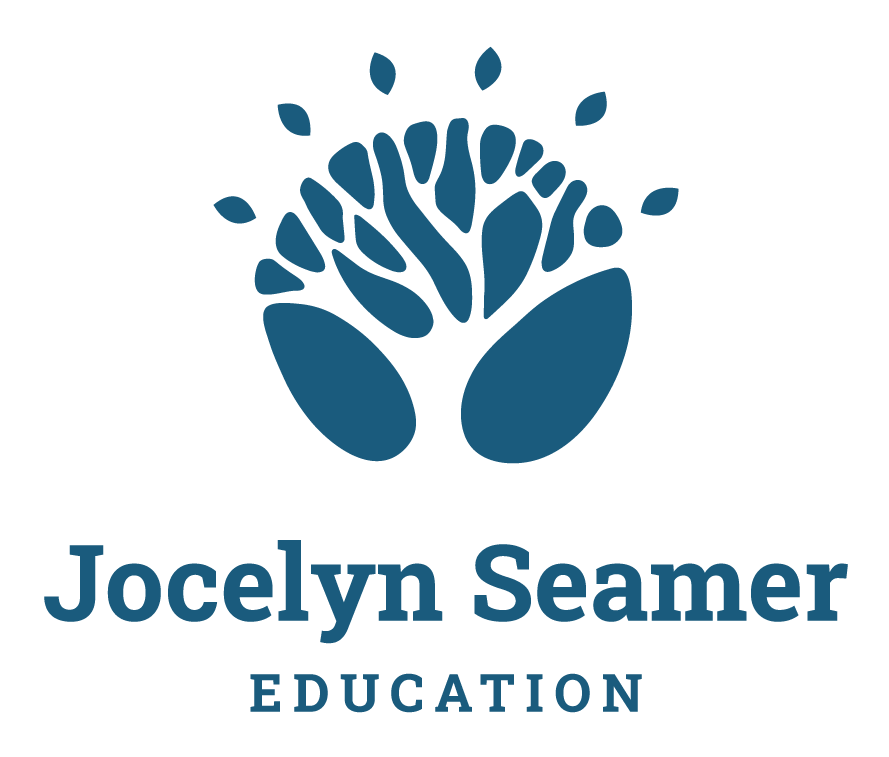S6 E21 - Why Exposure is a Poor Substitute for Learning

Well, hello. Welcome to this episode of the Structured Literacy Podcast. My name is Jocelyn, and I am recording here in Burnie, the home of the Palawa people. Welcome to Episode 21 of this season. We have a scenario that I'm sure is familiar to every listener. You have a student or a couple of students who clearly do not have the foundational knowledge that their peers do. We know that they're behind. We know that we can't be all things to all students. We hope that by including the student in the present lesson that they'll pick something up. We tell ourselves, or someone else tells us, that the student is getting exposure to the content and that this will be beneficial for their learning.
This is an idea that we hear often when it comes to phonics in particular. A Year 1 or 2 student might have significant gaps in their basic code knowledge, but they're given the same instruction as their peers. This decision is often accompanied by the words, we will give them exposure. Now, when I challenge this idea, the number one question I'm asked is, but how will they catch up if they aren't exposed to grade appropriate content? And my response is usually this question: talk to me about how they're catching up now, talk to me about what their data is showing.
How We Learn
Before we explore the ins and outs of instructional decisions, we need to unpack some details about human cognition and how we all learn. Firstly, let's consider that knowledge and skill can be divided into two categories: biologically primary and biologically secondary. Biologically primary skills are learned by being part of a community, by being with other humans, by what we could say is exposure. Biologically secondary knowledge and skill will not be learned unless it is explicitly taught.
Now let's think about what it means to be explicitly taught something. When we are explicitly taught something, we have our attention intentionally directed towards something. We hold it in our minds, we think about it, we do it, we practice, we're given feedback, we adjust, we get better, and over time we consolidate learning into long-term memory. We build schema and we become automatic. What I've described is an active process. We have to think, we have to focus, and we have to do the heavy lifting of applying cognitive effort in a way that leads to learning.
Let's contrast this to exposure. Exposure means that we are physically present when something happens or is said. Exposure means that the stimulus has entered our sensory register. Our eyes have noticed, our ears have noticed. When we have merely been exposed to something, it sits in our sensory register for just a couple of seconds and then disappears before it's completely forgotten. From the moment you woke up this morning until this moment when you're listening to this episode, you have had exposure to thousands of stimuli and you don't remember any of it. Exposure does not result in learning, not for skills and knowledge that are biologically secondary.
Why "Exposure" Then?
So why do we use this term when we think about instruction? I think there's a couple of reasons. The first one is a hangover from our whole language and balanced literacy roots. Even if we were not directly taught that immersion leads to learning, it's a deep unconscious belief in our profession that so many of our decisions are built on. If we say it, if we show it, if we create an immersive, engaging experience, students will learn. It just doesn't work. And particularly doesn't work for things that aren't naturally acquired. Reading and writing, as we know, are absolutely not naturally acquired and developed. The other reason that I think this word is used is because it's a term that I see often in research papers. Researchers describe the number of exposures that a student has had in a study. What they really mean is the number of times that a student has engaged with content, not how many times a student has been present when something has occurred. So there's a problem in that this word exposure is used by different people to mean different things.
One of the ways that we can support ourselves and our team is to be more precise in the language we use. If we mean engagement, we need to say engagement. If we mean repetitions, we need to say repetitions. If we mean exposure in that we're going to provide an experience that students may or may not grab hold of and pick up, then we need to use the right word for that.
Classroom Scenario
Let's return to our classroom scenario. We have a student in Year 1, 2, 3, 4, or beyond who's missing foundational knowledge such as phonics. We have them participate in a lesson designed for their peers who have this knowledge or are developing this knowledge in an appropriate way. We have them in the lesson in the name of exposure. We give them what we call "extra scaffolding" in inverted commas. We walk them step by step through every single aspect of the lesson or the task. They write things down, looking to an adult or another student for confirmation or modelling before every step. Essentially, they are doing what they're told or they're copying. At the end of the task, they have something on the paper or the board, and it may even be correct, but have they learned something?
To answer this question, let's go back to my description of being taught something explicitly. Earlier I said, when we are explicitly taught something, we have our attention intentionally directed towards the learning. We hold it in our minds, we think about it, we do it, we practice, we get feedback, we adjust, we get better over time. What I've described is an active process. We have to think, we have to focus and do the heavy lifting of cognitively processing what has happened. And if you're thinking, oh, have I accidentally skipped back in the episode? No, you haven't. I'm repeating this for a reason.
For our struggling student, let's compare this explanation of the active process of learning with their experience. We've directed their attention towards something, but they haven't necessarily held it in their mind. They haven't done the cognitive heavy lifting that is needed to encode knowledge into long-term memory and build schema. Often, at best, what we're seeing is that the student has complied. They've done what we asked them to, they've copied. Whether that copying is by watching someone and literally copying what they do or writing down what someone tells them to write, but they haven't thought for themselves because they couldn't. It is this point that separates experiences that do and do not lead to learning.
Exposure Without Expectation
When I taught preschool, four-year-old preschool, I often provided experiences that I called exposure without expectation. That meant that I knew, particularly here in Tasmania where our preschool children are five most of the time, at some point during that year, that we had students who were able to hook on to what we were doing. They were excited, they were ready, but there were others who just weren't there in the same spot. So I provided exposure to things like full stops and finger spaces. And indeed, I taught phonics in a very developmentally appropriate way within a play-based program, don't worry anyone who's early years. But I wasn't expecting that of everyone. I don't see a problem with exposure without expectation. What I do see is a very real issue with exposure with expectation.
Whether we are evaluating the effectiveness of a program or practice, or whether we are making a decision about the suitability of a lesson for a particular student, this question of cognitive heavy lifting and active engagement is the deciding factor about whether it's ok or not. If the gap between the student's current knowledge and the skill and what is required to complete the task is too big, the load on working memory is simply too high. It then becomes impossible for the student to learn effectively. There are just too many things they have to process in working memory.
What about a new student?
I appreciate that what I'm sharing here might be challenging. I also appreciate that there are many scenarios and nuances to consider. For example, what if you have a student who comes to your school without the foundational knowledge needed to read and spell the same words as their peers? Now the student doesn't have any particular learning challenges, they seem to have a strong memory based on what you've seen. Should you keep them with the rest of the class for spelling and reading, or should they be given different work? My response is that if the student can manage the work, that they aren't stressed, they can actively engage in what you're teaching, and that when you check in on their progress, you can see real growth in their data, well, then keep them with everyone else. The answer to this also depends on the what you are teaching.
If you're teaching a text-based unit focused on a narrative text, then we will provide adjustment so that the student can access and engage with age-appropriate learning. There's no question about age-appropriate text and learning in that top part of the rope. That is where we're dealing with comprehension, vocabulary, language devices, and structure. Students might need adjustment to access text and to record their ideas, but they can think and they can talk with their peers.
When it comes to the bottom of the rope, however, the nuts and bolts of written language, where each bit needs to be learned to mastery before adding the next bit, then that's where it's a different story. It's here in this area of literacy, as with the basics of number, that we need to be super targeted in our approach.
Think About the Strugglers
As you sit with what I've shared here and think about how it does or doesn't align with your experience and what you're being told by others, think about the students who you know are struggling, the ones whose data is just not moving, the ones who, if we are really honest, we know aren't being served. Remember at the start of the episode, I said when I'm asked this question about how will they catch up, my response is to ask the question, talk to me about how they're catching up now. It is the data that helps us evaluate the appropriateness and effectiveness of our decisions. This is not an ideological conversation. This is about student learning and about saying the only acceptable outcome here is that the student is learning and we will do what is necessary to make that happen.
Make your decisions, not based on what I've said here today. This isn't a "Jocelyn said so I have to" situation. But make your decisions by what it takes to move the needle for the students. Do your own reading about how humans learn. Look up information processing theory, read about cognitive load theory and how fragile working memory is. Do all of that and then come to the decision that is best for the students, not the decision that is easiest for the adults.
Making decisions for student learning that respond to their needs is hard. We have one of the most complex jobs and workplaces anywhere. You have 20, 25, 30 little people in front of you, and they're still little people even in the upper grades of primary school. We have all of these students who need different things often at different times, and the juggle can feel really hard. But if we make student learning the true north of decision making, it helps us to strip away the yeah-buts, and the Mildred conversations, and "but this person told me." Think about what is best for the student and honour your role in crafting the learning environment for them. And it will be ok. That's all from me for this episode of the Structured Literacy Podcast. Until next time, happy teaching. Bye.
Looking for a 12-month coaching and PL partnership to discover how to explicitly teach in your school? Find out more here.


 Jocelyn Seamer Education
Jocelyn Seamer Education
0 comments
Leave a comment